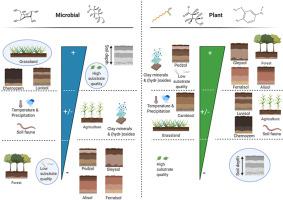Soil Biology and Biochemistry ( IF 9.7 ) Pub Date : 2021-03-01 , DOI: 10.1016/j.soilbio.2021.108189 Gerrit Angst , Kevin E. Mueller , Klaas G.J. Nierop , Myrna J. Simpson

|
Soil organic matter (SOM) represents a major reservoir of stored carbon (C). However, uncertainties regarding the composition and origin of stabilized SOM hinder the implementation of sustainable management strategies.
Here, we synthesize data on the contribution of plant- and microbial-derived compounds to stabilized SOM, i.e., aggregates and mineral-associated organic matter (MAOM), and review the role of environmental factors influencing this contribution. Extrapolating amino sugar concentrations in soil based on molecular stoichiometry, we find that microbial necromass accounts for ~50% (agroecosystems) or less (forest ecosystems) of the C stabilized within aggregates and MAOM across studies. This implies that plant biomolecules, including lipids, lignin, and sugars, might account for a substantial portion (≥50%) of the organic matter protected by minerals and aggregates. Indeed, plant-specific sugars and lipids can each account for as much as 10% of organic C within mineral soil fractions, and most reported quantities of plant-specific lipids and lignin in mineral soil fractions are likely underestimates due to irreversible sorption to minerals. A relatively balanced contribution of plant and microbial biomolecules to stabilized SOM in aggregates and MAOM is inconsistent with recent suggestions that stable SOM is comprised mostly of microbial compounds.
Land use and soil type appear to profoundly affect the contribution of plant and microbial compounds to stabilized SOM. Consistent with studies of bulk soils, favorable conditions for microbial proliferation in grasslands or fertile Chernozems or Luvisols appear to increase the contribution of microbial compounds, while less favorable conditions for microbial proliferation in forest soils or Podzols/Alisols appear to favor the abundance of plant compounds in stabilized SOM. Combined with a tight link between substrate quality and the abundance of microbial compounds in stabilized SOM, and a potentially inverse relationship between substrate quality and the abundance of plant compounds, these results provide evidence that plant biomolecules might be preferentially stabilized by organo-mineral interactions in some ecosystems.
Various areas warrant further research. For example, difficulties in distinguishing direct and indirect effects of temperature and precipitation on the composition of stabilized SOM may be overcome by long-term observational studies that include climate manipulations. Knowledge gaps in the contribution of plant and microbial compounds to stabilized SOM in soil layers below 30 cm depth may simply be closed by extending the sampling depth. Moreover, a refined focus on soil fauna, with potentially strong effects on microbial and plant compounds in stabilized SOM, will provide new insights into SOM dynamics. Future studies should quantify both microbial and plant biomolecules in mineral soil fractions to allow direct comparisons and overcome limitations in existing data. For example, because biomarker-based estimates of microbial-derived C can only indirectly estimate the maximum amount of plant-derived C, exhaustive studies of plant biomarker concentrations could be conducted, including estimates of plant-specific lipids, sugars, and lignin (and biomarkers released following mineral dissolution). Generally, more integrative studies, e.g., combining molecular and isotopic tracers of organic matter inputs with targeted sampling of mineral fractions, are required to improve knowledge of the formation and persistence of stabilized SOM.
中文翻译:

植物或微生物来源?稳定土壤有机质的分子组成研究进展
土壤有机质(SOM)代表了主要的碳存储库(C)。但是,关于稳定的SOM的组成和来源的不确定性阻碍了可持续管理策略的实施。
在这里,我们综合了植物和微生物来源的化合物对稳定的SOM(即聚集体和矿物相关的有机物(MAOM))的贡献的数据,并回顾了环境因素对这一贡献的影响。根据分子化学计量学推断土壤中的氨基糖浓度,我们发现在整个研究中,微生物坏死菌占稳定在骨料和MAOM中的C的〜50%(农业生态系统)或更少(森林生态系统)。这意味着包括脂质,木质素和糖在内的植物生物分子可能占矿物质和骨料保护的有机物的很大一部分(≥50%)。实际上,植物特定的糖和脂类各自可占矿物土壤级分中有机碳的10%,由于对矿物质的不可逆吸附,大多数报道的矿物质土壤组分中植物特异性脂质和木质素的含量可能被低估了。植物和微生物生物分子对稳定的SOM的聚集体和MAOM的贡献相对平衡,这与最近的建议不一致,即稳定的SOM主要由微生物化合物组成。
土地利用和土壤类型似乎对植物和微生物化合物对稳定的SOM的贡献产生深远的影响。与对大量土壤的研究一致,草原或肥沃的黑钙土或Luvisols的微生物繁殖的有利条件似乎增加了微生物化合物的贡献,而森林土壤或Podzols / Alisols的微生物繁殖的不利条件似乎有利于植物化合物的丰富在稳定的SOM中。结合底物质量和稳定的SOM中微生物化合物的丰度之间的紧密联系,以及底物质量和植物化合物的丰度之间的潜在反比关系,这些结果提供了证据,表明植物生物分子可能会优先通过有机矿物质相互作用而稳定下来。一些生态系统。
各个领域都需要进一步研究。例如,通过包括气候操作在内的长期观察研究可以克服区分温度和降水对稳定的SOM组成的直接和间接影响方面的困难。深度小于30 cm的土壤层中植物和微生物化合物对稳定的SOM的贡献中的知识差距可以通过扩展采样深度来弥补。此外,对土壤动物的精细关注可能会对稳定的SOM中的微生物和植物化合物产生强大的影响,这将为SOM动力学提供新的见解。未来的研究应量化微生物和在矿物土壤级分中添加植物生物分子,以便进行直接比较并克服现有数据的局限性。例如,由于基于生物标志物的微生物衍生C估算值只能间接估算植物中C的最大含量,因此可以对植物生物标志物浓度进行详尽的研究,包括对植物特异性脂质,糖和木质素(和矿物溶解后释放的生物标志物)。通常,需要进行更综合的研究,例如将有机物输入的分子和同位素示踪剂与矿物组分的目标采样相结合,以提高对稳定SOM的形成和持久性的了解。


























 京公网安备 11010802027423号
京公网安备 11010802027423号